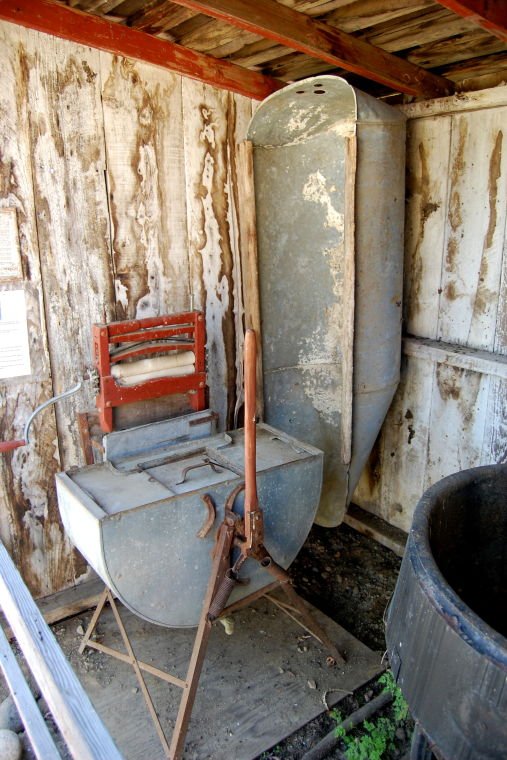Other cities in our region are preserving and celebrating their agricultural heritage, and in the process creating centers where that pull together their community, offer fun, recreation and a draw for tourism. This posting and the next will show examples we can learn from:
{{tncms-asset app=”editorial” id=”cf751586-f31e-11e3-bf81-001a4bcf6878″}}
Watsonville
I hope you will enjoy this supplement to my earlier blog on the Agriculture History Project of the Central Coast (http://www.aghistoryproject.org). This excellent destination for families is located at the entrance to the Santa Cruz County fairgrounds, and here you will find groups and families wandering through the central barn and around the grounds, poring over exhibits and trying out relics of yesterday’s farm life—tools, tractors and plows, old carriages, working models of hay balers and other machines, milk bottles, fruit jars, a windmill, a water wheel, a tank house, and even an antique caboose.
Shoppers will find treasures in the gift shop, and serious farm buffs can access historical archives in the research center.
The History Project’s website is proud when it declares, “From potatoes and wheat to lettuce and strawberries, the Central Coast has supplied the world’s tables for over 150 years!” A glance at topics covered in their blog shows a wide variety of subjects: alpacas, branding, butter, cowboys, dairy, flowers, games, grilling, honey, horses, ice cream, logging, pie making, pruning, ranching, robotics, rope making, soap making, spinning wheel, Thanksgiving, tractors, and weaving yarn.
The History Project holds an annual “Day on the Farm” featuring hayrides, horses, crafts, games, making ice cream, churning butter, and milking practice cows. When I last visited, just prior to Easter, children were painting posters, decorating Easter baskets, petting rabbits, making costumes, hunting for eggs, learning to roll metal hoops and walk with stilts, gushing water from a group of hand-powered pumps, and riding in a tractor-pulled wagon; there was laughter everywhere!
Admission is free, but visitors are asked to help support the cause with a donation of $2 per person.
Hollister
San Benito County Historical Park (http://www.sbchistoricalsociety.org/sbc-historical-park.php) is on Highway 25, one mile south of Tres Pinos. The village includes historic homes (the Woods Cabin, the Sullivan House, the Garcia House, as well as the Ferrando House and Barn) and other buildings (Willow Creek School, the Dunneville Dance Hall, Cottage Bar and the Tres Pinos Jail); horse-drawn equipment such as a hearse, hay wagon, and a Dassel wagon; tractors include a 1941 John Deere, a 1952 Farmall, a 1952 Case, a Ferguson and a Gibson Model A. I found myself drawn to a transplanter that plowed, placed plants, watered the new plants, and even closed furrows.
Open daily from dawn to dusk, admission is free, though donations are welcome; there is a gate fee of $3.00 per vehicle, collected by San Benito County. For more information; to arrange a tour, obtain a group permit, or reserve a section, visit the web site or call San Benito County Public Works at 831-636-4170.
Wilder Ranch State Park (http://www.parks.ca.gov/?page_id=549), just north of Santa Cruz along Highway One, is about two miles past the stoplight for Western Drive. The site began as the main rancho supplying Santa Cruz Mission, later becoming a dairy. The grounds include an historic adobe as well as Victorian homes and a garden. Tours and living history demonstrations let you experience the life of early Central Coast ranchers and farmers.
You can stroll out to the sea shore or wander 34 miles of hiking, biking and equestrian trails that traverse coastal terraces and valleys. The 7,000 acres of Wilder Ranch State Park includes some land in crops, some cattle grazing, about 110 acres in native vegetation, Wilder Beach, salt marsh, and grassland. Some agricultural fields have been returned to wetland and creek habitats with native tree and plants like dogwood, alder, cottonwood and willows are a setting for wetland birds, and hawks nesting among red-legged frogs and other wetland animals. Snowy plovers make nests in a preserve, along with Harbor seals and sea otters while dolphins and migrating whales swim offshore. The park even extends to 1,800 feet up on Ben Lomond Mountain where deer, bobcats, coyotes and mountain lions are found.
Ohlone Indians lived here for centuries, trading local materials for goods from inland tribes. After 1791, when Mission Santa Cruz was built, the Spanish grazed cattle on tribal lands and European diseases devastated the Ohlone population.
In the 1830s, this land became known as Rancho del Refugio. Maria Candida Castro and her husband José Antonio Bolcoff became owners. Bolcoff was a Russian sailor who jumped ship and became a Mexican citizen. He built two adobes and one of the area’s first sawmills, and sold butter and cheese throughout the area. In 1871 Deloss Wilder and a partner bought 4,160 acres of the former rancho. The Wilder family worked the land for five generations, even harnessing water power to drive their equipment. In 1969 property taxes were greater than farm income, and Santa Cruz County citizens voted to protect the open space rather than allow a housing development.
Docents often dress in period clothing. The weather can be changeable; layered clothing is recommended. The park does not all allow dogs. Six horse camping sites are available. For information on accessibility and parking, call (831) 426-0505 or visit http://access.parks.ca.gov.
coming next week: farm parks in San Jose, Cupertino and Fremont













